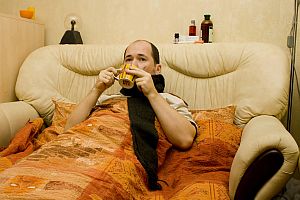How to Know if Stress is Affecting Your Health and Well-Being
 Everyone deals with stress in their lives. And—in small doses—this can be a very good thing. Manageable amounts of stress can actually help you perform at your best and may even help you develop your abilities. However, far too many of us are stressed to the point that our health and well-being could be compromised.
Everyone deals with stress in their lives. And—in small doses—this can be a very good thing. Manageable amounts of stress can actually help you perform at your best and may even help you develop your abilities. However, far too many of us are stressed to the point that our health and well-being could be compromised.
Stress: Helpful or Harmful?
When you are in a dangerous situation, your body responds with a rush of chemicals. This “flight-or-fight” response leads to an increased heart rate, quicker breathing, and higher blood pressure. In a truly dangerous situation, this response helps you make fast decisions and prepares your body for quick action that could save your life. Your body is able to handle this response in small doses over short periods of time, but when your body is constantly on “high alert,” your health pays the price.
Unfortunately, your body doesn’t differentiate between a physical threat (such as being attacked by a bear) and a psychological one (such as being three months behind on your electric bill). Therefore, everyday life is filled with interactions that could trigger a stress response in certain circumstances. A car honking at you on the highway, your boss reprimanding you in front of your peers, a call from your child’s teacher, and hundreds of other common occurrences can have a very real impact on your physical, cognitive, and emotional well-being. And their effects can and do add up.
The Symptoms of Stress
Constant or repeated stressful incidents can take a heavy toll. The most insidious part of ongoing stress is that this toll is not always easy to spot. Stress levels can build up slowly, and many people become acclimated to a “new normal” without realizing that it’s happening. Knowing how to spot the symptoms of stress can help you break the cycle by either addressing the underlying causes or by finding more effective ways to deal with the stress itself.
Have you noticed any of the following symptoms?
- Constant worrying or anxiety
- Inability to concentrate
- Agitation or irritability
- Feelings of loneliness, isolation, or depression
- Digestive issues, such as upset stomach, diarrhea, or constipation
- Insomnia or low energy levels
- Chest pain or rapid heartbeat
- Appetite changes
- Substance abuse
- Nervous behaviors, such as fidgeting or nail biting
These are just a few of the signs of stress overload. Consistently feeling stressed can also exacerbate other health problems, including infertility, depression, skin conditions, autoimmune disease, and heart disease. Stress may also encourage people to turn to unhealthy coping mechanisms, such as overindulging in comfort food, drinking or smoking too much, or lashing out at friends and family, which can further impact their physical and emotional well-being.
Healthy Ways to Cope With Stress
Coping with stress in a healthy and productive way can help you to manage its physical, psychological and emotional impacts. While you can’t always control the stressors in your life, you can control how you respond. By avoiding unnecessary stress, adapting to new situations, and accepting the things you can’t change, you can reduce the physical toll stress takes on your body.
Improving your overall physical health can also improve your body’s response to stress. It might be difficult to know where to start, so consider meeting with your chiropractor to learn more. Your chiropractor can help you create lifestyle strategies to leave you feeling healthier, happier, and better able to deal with life’s many stressors.
Do We Really Get Sick More Often During the Winter?
 Although your mother may have admonished you when you to bundle up when you went outside during the winter to avoid getting a cold, science shows that this advice is actually pretty ineffective. While it seems to be true that people tend to get sick more often during winter, it has nothing to do with getting a chill. Scientists do have a few alternative explanations for this phenomenon.
Although your mother may have admonished you when you to bundle up when you went outside during the winter to avoid getting a cold, science shows that this advice is actually pretty ineffective. While it seems to be true that people tend to get sick more often during winter, it has nothing to do with getting a chill. Scientists do have a few alternative explanations for this phenomenon.
First of all, we tend to spend a lot more time indoors when it’s cold outside. Germs are spread far more easily in a crowd or within enclosed spaces. The more people in an enclosed space with a sick person, the more people with an opportunity to become infected. However, this doesn’t explain why children in crowded classrooms get sick more often during winter months, even when the number of students present in the classroom may not change much (or at all) from season to season.
One aspect of winter conditions is that the air is colder and drier. Dry air dehydrates our nasal passages and makes it more difficult for the mucus membranes in our respiratory system to trap and sweep away pathogens, which it typically does more effectively in a warmer, more humid environment. This is one reason why travelers often become ill after enduring a long plane flight– the atmosphere of the cabin is very dry. Add this to the combination we talked about before (lots of people in an enclosed space for a prolonged period of time), and it’s easy to see why a cold virus or flu virus would have a much easier time infecting more individuals in this sort of situation.
In addition, a study has shown that the flu virus in particular survives far longer in cool, dry conditions than in warm ones. Peter Palese and colleagues at the Mount Sinai School of Medicine in New York conducted an experiment on guinea pigs. They found that when guinea pigs were exposed to the flu virus they infected each other quite easily in cool, dry air, but when the temperature was 86°F the guinea pigs could not infect one another at all.
Another theory advanced by some scientists is that in winter our bodies are often low in stores of vitamin D due to a lack of sunlight. Vitamin D deficiency has been shown to cause a reduction in immunity. Given that much of the population in the developed world lives at latitudes where even direct sun is often weak in winter and that these same people are more likely to use sunscreen, it’s not surprising that many don’t have enough vitamin D. Studies show that flu season in different parts of the world correlates with cold weather and short hours of daylight. In the northern hemisphere, cold and flu season runs from November to March, and in the southern hemisphere from May to September. Meanwhile, the tropics have no cold and flu season at all.
Another contributor to a lowered immune system is sugar intake. Around the holidays, people not only find themselves gathering in large groups more frequently (think about office festivities, family celebrations, crowded shopping malls, etc.), but there are also more sweets to be had, which also works to suppress our immune system.
According to health experts, the best thing you can do to avoid winter colds and flu is to wash your hands frequently, since germ-covered hands are the most common way we infect ourselves. It’s not necessary to keep your house at tropical temperatures, but a humidifier may help reduce the drying out of your respiratory passages. Finally, taking a vitamin D supplement and keeping the sweets to a minimum may help reduce the number of times you get sick each year.
The Power of Gratitude on Health
How we think and how we process the world around us has a tremendous effect on our health and our happiness. In celebration of this time of Thanksgiving, take some time out for yourself and contemplate all the many things that you have to be grateful for. If you find the task difficult, keep at it – it will get easier. Then, make it a daily habit – you will never be sorry that you decided to make gratitude a daily part of your life!

What’s Your New Year Plan?
 Each year millions of people make New Year’s resolutions and each year millions fail to accomplish the desired results. Why is this? Because a resolution represents change, something many people are resistant to…in fact, some even fear it. Positive changes are never easy, but will always result in personal growth. Mahatma Gandhi said “You must be the change you wish to see in the world”. The two most important words in this quote are “YOU” and “BE”. “Be” is who you are, not merely how you act, it is what drives your actions. The reason so many fail to achieve success with their resolutions is they attempt to change what they “DO” instead of changing who they “BE” inside.
Each year millions of people make New Year’s resolutions and each year millions fail to accomplish the desired results. Why is this? Because a resolution represents change, something many people are resistant to…in fact, some even fear it. Positive changes are never easy, but will always result in personal growth. Mahatma Gandhi said “You must be the change you wish to see in the world”. The two most important words in this quote are “YOU” and “BE”. “Be” is who you are, not merely how you act, it is what drives your actions. The reason so many fail to achieve success with their resolutions is they attempt to change what they “DO” instead of changing who they “BE” inside.
Let’s consider the BE-DO-HAVE concept, which states that in order to achieve a desired result you must BE the type of person who will DO the things necessary to HAVE the desired outcome. Most people fall into the trap of attempting to change their actions (DO) without first changing who they are and how they think (BE).
For example, have you ever had a resolution that involved losing a certain amount of weight by trying some new fad diet? You may have been successful in the short term by following the recommended diet, but chances are you reached your goal and the diet went out the door and the pounds came back on. This is a classic example of trying to modify your actions without changing who you are and how you think. This approach will fail every time the focus is on the DOING not the Being.
Back to the title, “What is your New Year plan”? I will try to help you with a few quick and easy, but powerful tools to help you succeed.
1) Set Goals
The number one rule of goal setting is that your goals must be written. Writing your goals will materialize your thoughts… and thoughts motivate action. A useful acronym to help with goal setting is S.M.A.R.T. Make your goals Specific (you are more likely to achieve a specific goal than a general goal), Measurable (must have criteria for measuring progress), Attainable (Make sure you have or are developing the attitudes, abilities, skills, and financial capacity necessary for achieving your goal), Realistic (must represent an objective that you are willing and able to work towards), and Timely (must have a timeframe for accomplishing your goal).
2) Visual Success
Visualization is a process of holding a thought in your mind and allowing it to propagate into a mental picture that you can see, hear, feel, smell, and even taste. If you visualize yourself achieving your goals you are more likely to be successful. Implementing these tools and concepts will help you not only achieve, but sustain your New Year’s resolutions.
3) Affirm Your Intentions
Affirmations are positive statements that stimulate your mind with an attitude of Expectancy and are your opportunity to condition yourself to be exactly who you want to be. Some examples include: “I can do anything I want to do!”, “I am a happy person!”, “I am worthy of success!”, and “I am health!” Affirmations should always be written and read with regularly and should support whatever it is that you are working towards. They should be written in first person and in present tense. For example “I am…” vs. “I will…” Affirmations are best done at the beginning of your day and should be carried around with you as a reminder, and most importantly they should be said aloud with enthusiasm!
December is a great month to start organizing your New Year Plan. My hope is that you will utilize and share this information with others so that we may all BE the change we wish to see in the world. As Thomas S. Monson says, “The Future is as bright as our Faith.” Where can you go in 2013 and what can you accomplish if you exercise faith in yourself and in your ability to learn to make great choices? Here’s to a bright future!
PS – If weight loss is a part of the changes you are seeing for yourself in 2013, let us help! Our weight loss program is designed to help you make a successful transition in not only reducing your weight but in your health habits and life choices as well! Go to www.healthyhabitsbillings.com or call our office at 406-652-3553
Chiropractic Boosts Immunity!!!
 We wanted to share this article. We see the influence that chiropractic adjustments have on immunity and overall health all the time. However, we know that our patients seldom get to have that amazing vantage point that we do! With the cold and flu season upon us and for overall health – make sure you keep you and your loved ones adjusted!
We wanted to share this article. We see the influence that chiropractic adjustments have on immunity and overall health all the time. However, we know that our patients seldom get to have that amazing vantage point that we do! With the cold and flu season upon us and for overall health – make sure you keep you and your loved ones adjusted!
Chiropractic Boosts Immunity
Friday, February 04, 2011 by: Dr. David Jockers
The nervous system and immune system are hardwired and work together to create optimal responses for the body to adapt and heal appropriately. Neural dysfunctions due to spinal misalignments are stressful to the body and cause abnormal changes that lead to a poorly coordinated immune response. Chiropractic adjustments have been shown to boost the coordinated responses of the nervous system and immune system.
The autonomic nervous system is hardwired into the lymphoid organs such as the spleen, thymus, lymph nodes, and bone marrow that produce the body’s immune response. Growing evidence is showing that immune function is regulated in part by the sympathetic division of the autonomic nervous system.
Subluxation is the term for misalignments of the spine that cause compression and irritation of nerve pathways affecting organ systems of the body. Subluxations are an example of physical nerve stress that affects neuronal control. According to researchers, such stressful conditions lead to altered measures of immune function & increased susceptibility to a variety of diseases.
Inflammatory based disease is influenced by both the nervous, endocrine, and immune systems. Nerve stimulation directly affects the growth and function of inflammatory cells. Researchers found that dysfunction in this pathway results in the development of various inflammatory syndromes such as rheumatoid arthritis and behavioral syndromes such as depression. Additionally, this dysfunctional neuro-endo-immune response plays a significant role in immune-compromised conditions such as chronic infections and cancer.
Wellness based chiropractors analyze the spine for subluxations and give corrective adjustments to reduce the stress on the nervous system. A 1992 research group found that when a thoracic adjustment was applied to a subluxated area the white blood cell (neutrophil) count collected rose significantly.
In 1975, Ronald Pero, Ph.D., chief of cancer prevention research at New York’s Preventive Medicine Institute and professor in Environmental Health at New York University, began researching the most scientifically valid ways to estimate individual susceptibility to various chronic diseases. He has conducted a tremendous amount of research in this area that includes over 160 published reports in peer reviewed journals.
Pero and his colleagues discovered that various DNA-repairing enzymes could be significantly altered following exposure to carcinogenic chemicals. He found strong evidence that an individual’s susceptibility to cancer could be determined by these enzymes. Lack of those enzymes, Pero said, ‘definitely limits not only your lifespan, but also your ability to resist serious disease consequences.’
Pero was fascinated by the relationship cancer-inducing agents had on the endocrine system. Since the nervous system regulates hormone balance, he hypothesized that the nervous system had to also have a strong influence on one’s susceptibility to cancer.
To support this argument he found a substantial amount of literature linking various kinds of spinal cord injuries and cancer. Pero found that these injuries led to a very high rate of lymphomas and lymphatic leukemias. This understanding led Pero to consider Chiropractic care as a means of reducing the risk of immune breakdown and disease.
Pero’s team measured 107 individuals who had received long-term Chiropractic care. The chiropractic patients were shown to have a 200% greater immune competence than people who had not received chiropractic care, and a 400% greater immune competence than people with cancer or serious diseases. Interestingly, Pero found no decline with the various age groups in the study demonstrating that the DNA repairing enzymes were just as present in long-term chiropractic senior groups as they were in the younger groups.
Pero concluded, ‘Chiropractic may optimize whatever genetic abilities you have so that you can fully resist serious disease…I have never seen a group other than this show a 200% increase over normal patients.’
Kent, Christopher. Models of Vertebral Subluxation: A Review. Journal of Vertebral Subluxation Research. August 1996, Vol 1:1. Pg 4-5
Sternberg EM, Chrousos GP, Wilder RL, Gold PW. The stress response and the regulation of inflammatory disease. Ann Intern Med 1992; 117 (10):854
Brennan PC, Triano JJ, McGregor M, et al. Enhanced neutrophil respiratory burst as a biological marker for manipulation forces: duration of the effect and association with substance P and tumor necrosis factor. J Manipulative Physiol Ther 1992; 15(2):83
Preparing For the Holidays
 As we approach the holidays we want to focus on presence. That isn’t a typo. I’m referring to presence as in a state of being, rather than the typical presents that we think of this time of year which come wrapped up in fancy paper. If you are like most people you probably can’t remember the long list of gifts you’ve received over the years. While we appreciate the gifts and the people who gave them to us, most of those gifts get lost in the shuffle with all the other stuff we accumulate over time.
As we approach the holidays we want to focus on presence. That isn’t a typo. I’m referring to presence as in a state of being, rather than the typical presents that we think of this time of year which come wrapped up in fancy paper. If you are like most people you probably can’t remember the long list of gifts you’ve received over the years. While we appreciate the gifts and the people who gave them to us, most of those gifts get lost in the shuffle with all the other stuff we accumulate over time.
However, can you remember a gift that did have a long lasting impact on you, either because it was something that you truly wanted or needed or it had deep personal significance? When you think of that gift does it remind you of the person who gave it to you? The true gift is the presence of the people that we love and that love us. Think about times in your life that you shared with someone special and what that time together means to you. Then take a look at your life now and the people in it. Are you doing what it takes to create those special moments with the people you care about in your life?
In our fast-paced society it is easy to lose track of the things that are most important, the things that are going to mean something when our eulogy is being read. People often throw out the phrase, ‘It’s the quality of the time that matters, not the quantity’. Wrong, it’s both.
You can spend all kinds of time with someone and never have a meaningful exchange. On the other hand, you can have some great moments that stand out as the exceptions to the rules of the relationships in your life. I suggest that we should try to combine quality and quantity and create truly meaningful relationships in our lives.
“The most precious gift we can offer others is our presence. When mindfulness embraces those we love, they will bloom like flowers”~ Thich Nhat Hanh
Take this opportunity to evaluate your relationships. If you find that you are not doing all you can to nourish those relationships, recommit to improving the quality and quantity of the time you invest in them. This year and going forward, make your presence your present.
